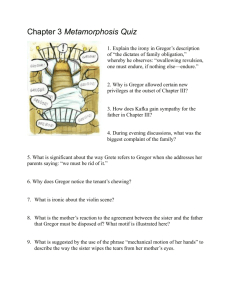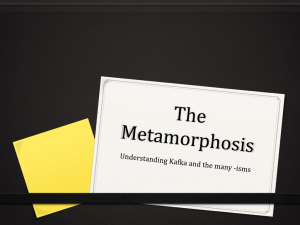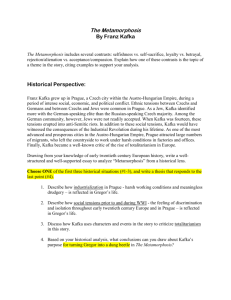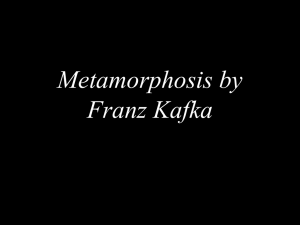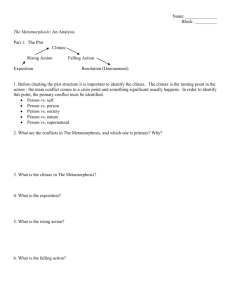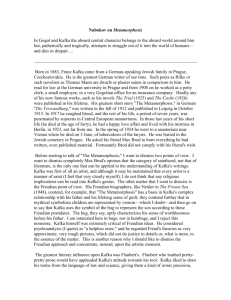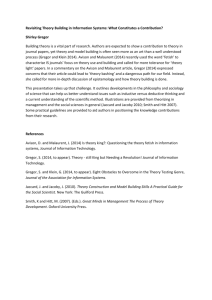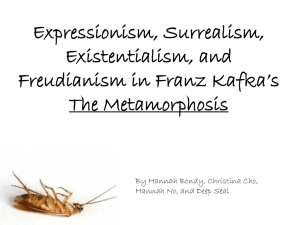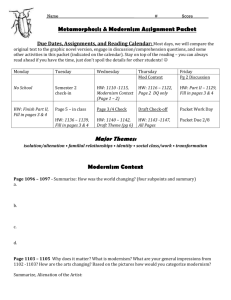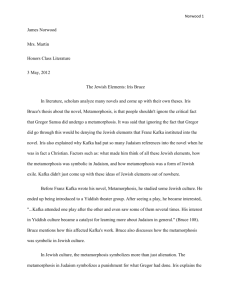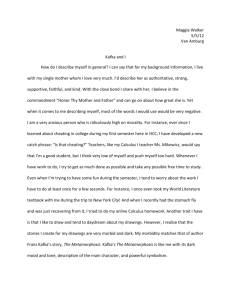Franz Kafka
advertisement
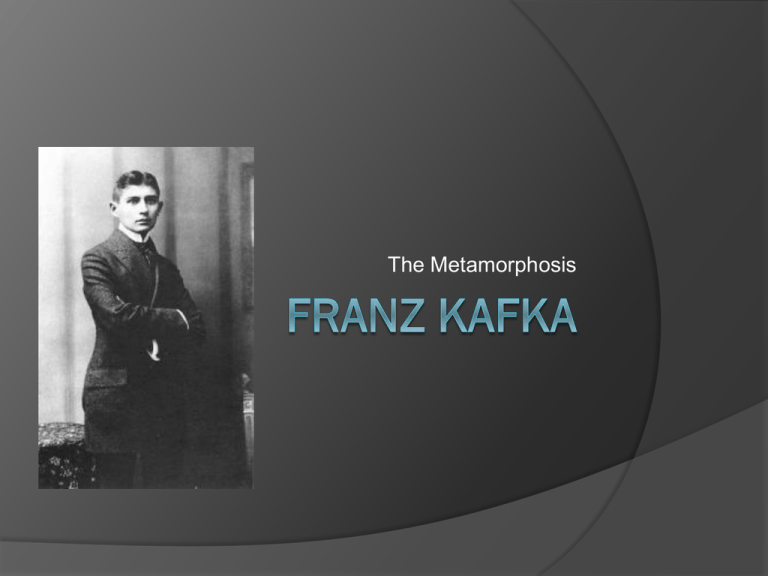
The Metamorphosis The Metamorphosis Great ending point for the semester a very specific study in Psychoanalysis and Formalism 1. Formalism and The Metamorphosis You should understand these literary terms: eponym and Kafkaesque defamiliarization novella Parable Existentialism (philosophy) (we will revisit) tragic hero, tragic sequence (Aristotle), symbol, metaphor, In your own words, define eponym. Sophoclean irony Aristolean tragedy Shakespearean scholar Homeric epithets Freudian psychology Modern: MacGyver, Shrute ………………………………………….. KAFKAESQUE Eponym An eponym is similar to an allusion, referring to a well-known person to link his or her attributes Meaning is usually known to educated people Comes into language from a person's name What does it tell us that Kafka (and his writing) has been labeled with an eponym? By the end of the period, you should be able to construct a definition of Kafkaesque based on your understanding of form and author. Compare these famous Opening Lines… “As Gregor Samsa awoke one morning from uneasy dreams he found himself transformed in his bed into a giant insect” (Kafka, The Metamorphosis). ….………………………………………………… “It was a bright cold day in April and the clocks were striking thirteen” (Orwell, Nineteen EightyFour 1). What do these two lines have in common? (Compare the beginnings of the sentences to the endings) Both sentences make their points through defamiliarization: They initially describe normal, everyday, almost boring events, only to disrupt this sense of normalcy at the very end. The disruption of reader’s expectation is called a defamiliarization effect – in German, Verfremdungseffekt, which translates as “alienation effect.” Taking the familiar and making it strange. Why would Kafka (or any author) want to alienate his audience? (Keep in kind that that Kafka is eponymic = highly regarded piece of literature and he is a highly regarded writer) Why does Kafka (in a non-science fiction piece of writing) have a human being wake up as an insect? It enhances our perceptions of the familiar This gives an aesthetic affect = literary art Take a minute to read Terrible Things This story is a parable . What is this a parable of? How would you define parable based on this example? Why do you think the author told the story of the Holocaust in this symbolic way? Why might an author choose to write in parable form? Definition of Parable At its simplest, a parable is a metaphor or simile drawn from nature or common life, arresting the hearer by its vividness or strangeness, and leaving the mind in sufficient doubt about its precise application to tease it into active thought. The Form of The Metamorphosis: Parable 1st person p.o.v. - Fictional narration used to convey a moral not openly stated Uses this literary form as a neutral, detached point of view from which to examine human behavior Conveys truth in a less offensive, more engaging form than a direct assertion Appeals to the understanding, the emotions, and the imagination—to the whole person Parable: The Complexity of Life The meaning of most parables is not so obvious, or at least it shouldn't be. Most parables contain some element that is strange or unusual. Parables do not define things precisely but, rather, use comparisons. Takes the familiar and applies it to the unfamiliar Makes the unfamiliar more comprehensible The bottom line… improbable or even impossible events in fiction often ask us to consider what the larger meaning of these events may be by disrupting our normal perspective on reality, unusual plotlines force us to ask profound questions 2. PSYCHOANALYSIS and The Metamorphosis What did you find to be striking or significant about Kafka’s life? Do a quick psychoanalytic prediction: How might the Kafka’s life and times have affected his writing? Franz Kafka…a bit of his bio. Czech-born in 1883 into a middle-class, German-speaking Jewish family in a very Catholic Prague Forced to attend German school Studied law Worked as a clerk for an insurance company in order to support his parents/sisters Had a very strained relationship with his tyrannical father Had very little time to devote to his writing He was a meek and sickly Developed MANY, many, many, many intense relationships…was engaged MANY times but could never follow through Suffered from clinical depression, social anxiety, and several other illnesses triggered by stress Contracted tuberculosis in 1917 and was supported by his sister and parents Died in 1924 from starvation when his tuberculosis worsened and he could not swallow So what did this all mean to him? Felt he was an outsider Feared being perceived as both physically and mentally repulsive Jewish in Catholic Prague Sickly Lonely Perceived human beings as being trapped by authority in a hopeless world Became frustrated with having to support his family Had to work in a meaningless job for which he was overqualified “just another pencil pusher” Took time away from his writing As a result… Franz Kafka’s writings often dealt with loneliness, isolation and alienation, all of which are aggravated by the social and economic systems that structure human relations. Consider FORM and AUTHOR Based on your understanding of eponym, defamiliarization, parable, and Kafka’s life, create a rough definition of KAFKAESQUE Kafkaesque = Used to describe something horrible and beyond the restraints of logic characterized by surreal distortion and a sense of impending danger Is a very interesting and identifiable style because its created out of psychoanalytic and formalist approaches to analysis Difficulties in Reading Kafka: Paradox and Ambiguity Not a systematic philosopher or religious man Is so convincing in his matter-of-factness and use of details to the point of negating the absurdity of a situation Does not use metaphors yet his stories are parables Uses distortion to reveal truths Suggests various levels of meanings Is quirky Setting the scene The protagonist of the story is Gregor Samsa, who is the son of middle-class parents in Prague. Gregor’s father lost most of his money about five years earlier, causing Gregor to take a job with one of his father's creditors as a travelling salesman. Gregor provides the sole support for his family (father, mother, and sister), and also found them their current lodgings in Prague. When the story begins, Gregor is spending a night at home before embarking upon another business trip. And then. . . Writers often use fantastic events to signify additional levels of meaning beyond the literal. Thus, we need to ask ourselves what Gregor’s metamorphosis signifies in terms of larger issues. Full of SYMBOLISM… Hospital Music The lodgers Insect The furniture Doors Picture of the woman The number three Gregor’s father’s uniform ?????? Central Symbol of the Beetle/Vermin A subjective fantasy that best describes Gregor’s self-loathing: Worthlessness Uselessness Meaninglessness Awkwardness Ugliness The ending: “The greatest immediate improvement in their condition would of course arise from moving to another house; they wanted to take a smaller and cheaper but also better situated and more easily run apartment than the one they had, which Gregor had selected. While they were thus conversing, it struck both Mr. and Mrs. Samsa, almost at the same moment, as they became aware of their daughter's increasing vivacity, that in spite of all the sorrow of recent times, which had made her cheeks pale, she had bloomed into a buxom girl. . .” “They grew quieter and half unconsciously exchanged glances of complete agreement, having come to the conclusion that it would soon be time to find a good husband for her. And it was like a confirmation of their new dreams and excellent intentions that at the end of their journey their daughter sprang to her feet first and stretched her young body.” How do you interpret the ending? What does it all mean? How good is your memory? Aristotle’s Poetics? Unity of Action? Apply it to The Metamorphosis… The Inward Passage: The Real Metamorphosis This is a novel about Gregor Samsa who learns about who he really is through an overwhelming psychological experience that turns him inward. His first step in this journey is disobedience: Refuses to go to work Refuses to follow the rules of etiquette In his new condition, Gregor begins his soul searching: Accepts that he has conformed to his family’s and employer’s demands Realizes the inauthenticity and meaninglessness of his life Once he sheds his previous self, Gregor begins to delve into his own unconscious and confront the truth of his life. Gregor evolves from psychological immaturity to the courage of self responsibility. For the very first time in his life, Gregor becomes blissful and becomes a mature person. Gregor dies with this realization, a transformed human being Gregor Samsa represents a specific type of behavior—the fear of being alive with all of its risks/rewards and the embrace of an inauthentic code of behavior—which, in the end, is transformed into the acceptance of life with all of its vicissitudes. How is this novella existential?
